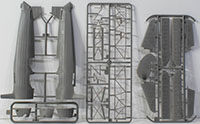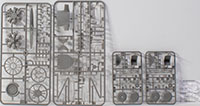
Roden 1/32 Stearman PT-17 Kaydet Kit First Look
By Michael Benolkin
| Date of Review | May 2020 | Manufacturer | Roden |
|---|---|---|---|
| Subject | Stearman PT-17 Kaydet | Scale | 1/32 |
| Kit Number | 0631 | Primary Media | Styrene |
| Pros | Nice details | Cons | Unbuildable (see text) |
| Skill Level | Experienced | MSRP (USD) | $64.99 |
First Look
 |
 |
 |
 |
The Stearman Model 75 was designed as a training aircraft that was adopted by the U.S. Army Air Corps, U.S. Navy, and the Royal Canadian Air Force to train new pilots as these countries entered World War 2. Over 10,600 examples were built before production ended. There is some confusion about the various designators for this aircraft, but all were based upon the same airframe. The PT-13 (USAAC) and the N2S-2/5 (USN) were powered by the Lycoming 9-cylinder radial engine. The PT-17 and N2S-1/4 were powered by the Continental 7-cylinder radial engine, while the PT-18 was powered by the Jacobs R-755 7-cylinder engine. All of the engines that powered the Model 75 in its different variants were rated at 220 horsepower. While Boeing acquired Stearman Aircraft in 1934, the aircraft was known as the Stearman in U.S. circles while the RCAF called the aircraft the Kaydet. When the aircraft entered civilian service after the war, one of the more popular upgrades, regardless of the variant, was to replace the aircraft's engine with the R-965 Wasp Jr. 9-cylinder radial engine rated at 300 hp and turning a constant-speed propeller.
Roden is back with another beauty in 1/32 scale - the Stearman! As with the full-scale aircraft, the kit is a simple layout and consists of nine parts trees molded in gray styrene plus one tree of clear parts. The molding is sharp with nice details inside the cockpits and around the airframe. Among the features and options in this kit:
- Nicely detailed Continental engine
- Nicely detailed cockpits
- Nice surface detail on the instrument panels and instrument faces provided as decals
- Positionable elevators
- Positionable rudder
- Positionable ailerons
- Nice design for fool-proof gear struts
The sizable decal sheet provides marking options for two aircraft:
- PT-17, BP-30, 4th British Flight Training School, Mesa, AZ, early 1940s
- PT-17, 42-16408, 88, U.S. Army Flight Training School, Mather Field, CA, 1942
A few notes to consider:
- The instructions provide a basic rigging illustration, but there are many good online resources for these details in more depth
- The engine has some sharp detailing, and while the two spark plugs are nicely presented, there isn't an ignition harness for all fourteen plugs. You'll need to provide your own wiring solution while referring to good online photos. Note that production Stearmans did not have cowlings (these came along in the post-war 'aftermarket'), so that nice engine will be visible to all
- The markings provide two good examples of color schemes, one in trainer yellow, the other in blue/yellow. You can find other paint schemes and markings information online and hopefully some aftermarket decal options soon
- The painting instructions are laid out using only Vallejo color references but I have no idea where they got their color recommendations. See the color section below
- Take some time and care at the beginning to clean off the mold flash on the thinner parts like the cockpit interior frames as this new-tool kit does seem to have a flash problem
Colors: I was looking through Roden's color recommendations on the back of the instruction sheet and initially I just figured these came from Vallejo. If they did, I am very disappointed in their color team. The Vallejo paints are an odd selection of Model Aire (airbrush-ready) and Model Color (must be thinned first) paints, but on further examination, some of these colors don't align with the colors used in that era, and these paints do not align with the published color recommendations Vallejo has for the pre-war ANA color standards. In short, we'll fix this. First a bit of perspective - during the years prior to and during World War II, the Stearman (and other trainers) came in three basic color schemes: Overall Orange-Yellow (ANA 506) used by the USN/USMC, Overall Silver Dope (ANA N/A) used by the USAAC/USAAF, and True Blue (ANA 501) fuselage with Orange-Yellow (ANA 506) wings/tail used by the USAAC. The airframe is overall fabric, so regardless of whatever is on the outside, the inside is silver dope. The metal stringers may be silver or a light gray from period photos, while the tubular cockpit structure and metal cockpit fixtures are either bronze green or interior green (ANA 611). The instructions indicate the interior is chromate green, and while some warbirds are painted that way, I haven't seen any examples out of that era. An excellent reference is the PT-17 restoration photos on the National Museum of the United States Air Force website which provide some nice interior shots. There are other useful color details there as well. As always, check your own references.
Here is a list of paints representing the ANA colors used by the Stearman:
ANA 501
B220
C220
ANA 506
H329
B066
C066
ANA 512
XA1138
ANA 611
H058
N058
B211
C211
A007
XA1117
H008
N008
B003
C003
36190
LP11
X11
Roden has done a great job with this kit and they can offer other variants of the Stearman by simply swapping out engines. You don't have to wait for that to happen as there are resin engines in the aftermarket that will allow you to render just about any variant, wartime or postwar, you might wish to build. I wound up purchasing two, one to build as the PT-17, the other as an N2S, but I'm still undecided whether to swap engines as described in the introduction.







